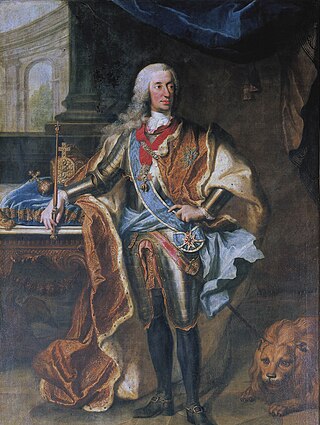
Charles VII was Prince-Elector of Bavaria from 26 February 1726 and Holy Roman Emperor from 24 January 1742 to his death. He was also King of Bohemia from 1741 to 1743. Charles was a member of the House of Wittelsbach, and his reign as Holy Roman Emperor thus marked the end of three centuries of uninterrupted Habsburg imperial rule, although he was related to the Habsburgs by both blood and marriage.

Ludwig I or Louis I was King of Bavaria from 1825 until the 1848 revolutions in the German states. When he was crown prince, he was involved in the Napoleonic Wars. As king, he encouraged Bavaria's industrialization, initiating the Ludwig Canal between the rivers Main and the Danube. In 1835, the first German railway was constructed in his domain, between the cities of Fürth and Nuremberg, with his Bavaria joining the Zollverein economic union in 1834. After the July Revolution of 1830 in France, Ludwig's previous liberal policy became increasingly repressive; in 1844, Ludwig was confronted during the Beer riots in Bavaria. During the revolutions of 1848 the king faced increasing protests and demonstrations by students and the middle classes. On 20 March 1848, he abdicated in favour of his eldest son, Maximilian.

The Nymphenburg Palace is a Baroque palace situated in Munich's western district Neuhausen-Nymphenburg, in Bavaria, southern Germany. The Nymphenburg served as the main summer residence for the former rulers of Bavaria of the House of Wittelsbach. Combined with the adjacent Nymphenburg Palace Park it constitutes one of the premier royal palaces of Europe. Its frontal width of 632 m (2,073 ft) even surpasses Versailles.
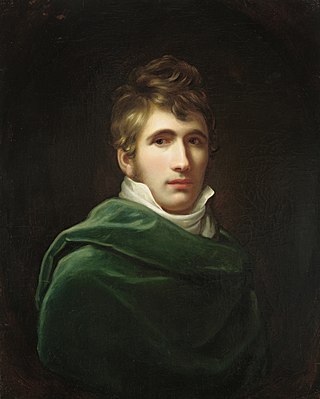
Joseph Karl Stieler was a German painter. From 1820 until 1855 he worked as royal court painter for the Bavarian kings. He is known for his Neoclassical portraits, especially for the Gallery of Beauties at Nymphenburg Palace in Munich, as well as his emblematic portrait of Ludwig van Beethoven, which has become one of his most famous works.
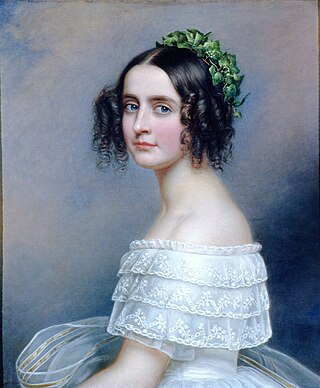
Princess Alexandra Amalie of Bavaria was a German princess and writer.
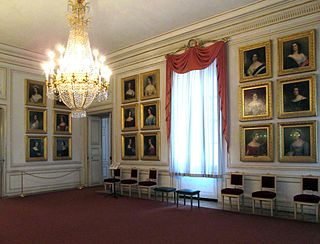
The Gallery of Beauties is a collection of 38 portraits of the most beautiful women from the nobility and bourgeoisie of Munich, Germany, gathered by Ludwig I of Bavaria in the south pavilion of his Nymphenburg Palace. All but two of the portraits were painted between 1827 – 1850 by Joseph Karl Stieler, with two additional portraits created by Friedrich Dürck, a student of Stieler's. The collection's best-known works are the portraits of the shoemaker's daughter Helene Sedlmayr, the actress Charlotte von Hagn, Marianna Marquesa Florenzi, and Eliza Gilbert. They also include a Briton, a Greek, a Scot and an Israelite, along with relations of Ludwig's – the wife and daughter of Ludwig of Oettingen-Wallerstein were both painted, as was Ludwig I's daughter Princess Alexandra of Bavaria. All 38 women pictured were rewarded for modeling by Ludwig I. He took over their dowry, paid them an allowance or found them a job at court. He remained in active correspondence with some of them for years, while others only briefly crossed his life.

Marchioness Marianna Florenzi, née Marianna Bacinetti, was an Italian noblewoman, philosopher and translator of philosophical works. She was also known by her married name of Marianna Florenzi Waddington.

Auguste Strobl was a Bavarian beauty of the 19th century. The daughter of a royal chief accountant, she also appeared in the Gallery of Beauties gathered by Ludwig I of Bavaria.

Katerina "Rosa" Botsari was a Greek courtier. She was member of the Souliot Botsaris family. The daughter of Markos Botsaris, she was in the service of Queen Amalia of Greece as well as an admired young woman throughout the European courts - she was immortalised for the 'Gallery of Beauties' of Ludwig I of Bavaria in an 1841 painting by Joseph Stieler. A Damask rose species bred in 1856 was named Rosa Botsaris after her. In 1845 she married prince and general George Caradja.

Princess Maximiliana Josepha Caroline of Bavaria, was a Princess of Bavaria, daughter of King Maximilian I Joseph of Bavaria and Queen Caroline of Baden.
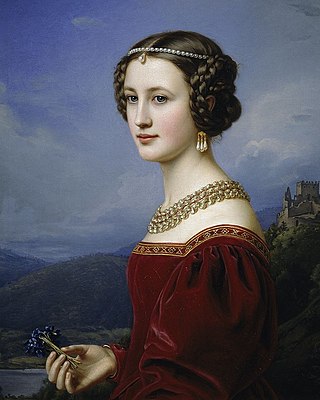
Antonietta Cornelia Vetterlein, Baroness von Künsberg was a Bavarian beauty of the 19th century. She was the granddaughter of Bayreuth Court Gardner Schneider and the daughter of State Councillor Vetterlein. She appeared in the Gallery of Beauties gathered by Ludwig I of Bavaria in 1828.
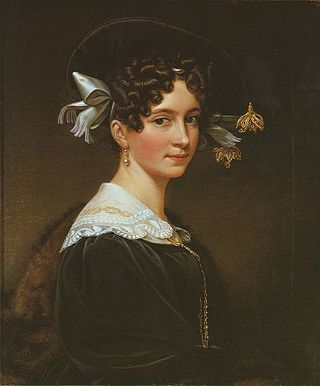
Maximiliane Borzaga was a Munich beauty of Italian descent, whose portrait was included in the famous Gallery of Beauties of the Bavarian King Ludwig I.

Anna Hillmayer was a Munich beauty whose portrait was included in the famous Gallery of Beauties of King Ludwig I of Bavaria.

Amalie von Schintling was a Bavarian beauty of the 19th century. She gained notoriety through her portrait in the Gallery of Beauties in Nymphenburg Palace.

Marquise Irene of Pallavicini or Countess Irene von und zu Arco-Zinneberg was a Hungarian-born palace lady in the court of Munich in the 19th century. She appeared in the Gallery of Beauties gathered by King Ludwig I of Bavaria in 1834.

Baroness Mathilde von Jordan was a German noblewoman who appeared in the Gallery of Beauties gathered by Ludwig I of Bavaria in 1837.

Friederica Catharina Sulzer better known for her stage name as Wilhelmine Sulzer was a Munich royal court actress. She appeared in the Gallery of Beauties gathered by Ludwig I of Bavaria in 1838.
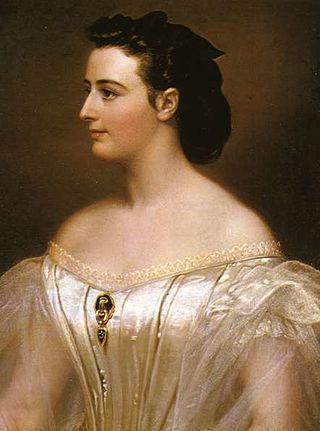
Anna von Greiner was a German 19th century woman. She appeared in the Gallery of Beauties gathered by Ludwig I of Bavaria in 1861, painted by Joseph Stieler's nephew and pupil Friedrich Dürck.

Countess Carlotta von Boos-Waldeck born as Baroness Carlotta von Breidbach-Bürresheim was a German lady-in-waiting for Grand Duchess Mathilde of Hesse-Darmstadt. She appeared in the Gallery of Beauties gathered by Ludwig I of Bavaria in 1863. Her portrait was the last of the collection for the Gallery.

Caroline Lizius was a German soprano in the Munich court music between 1844 and 1848. She also appeared in the Gallery of Beauties gathered by King Ludwig I of Bavaria in 1842.




















